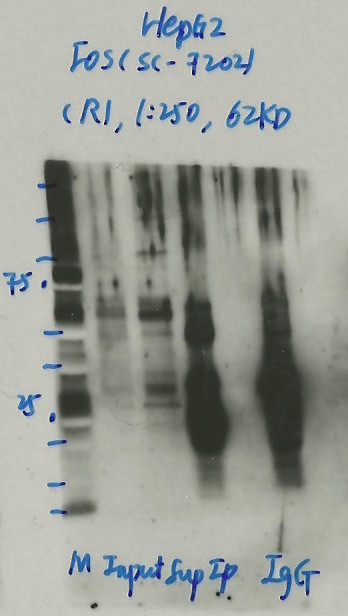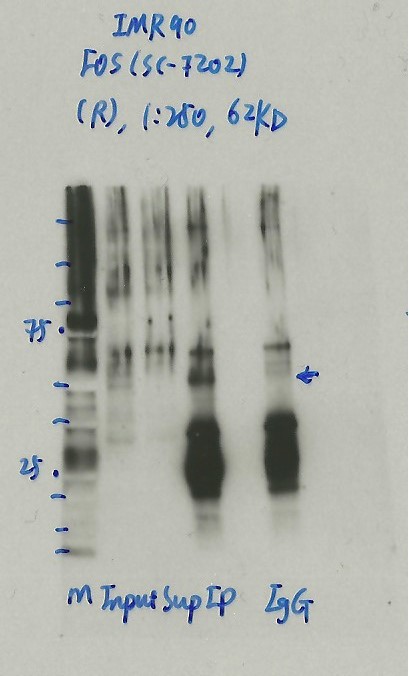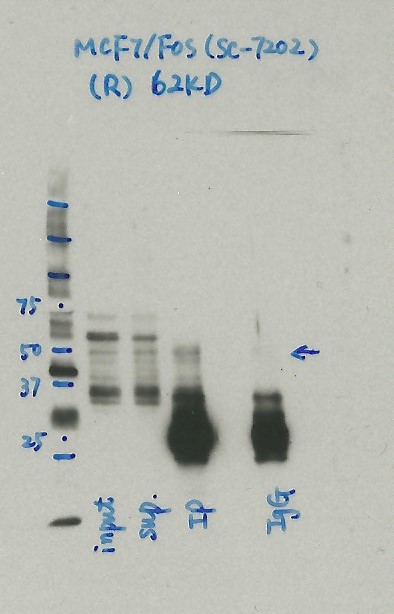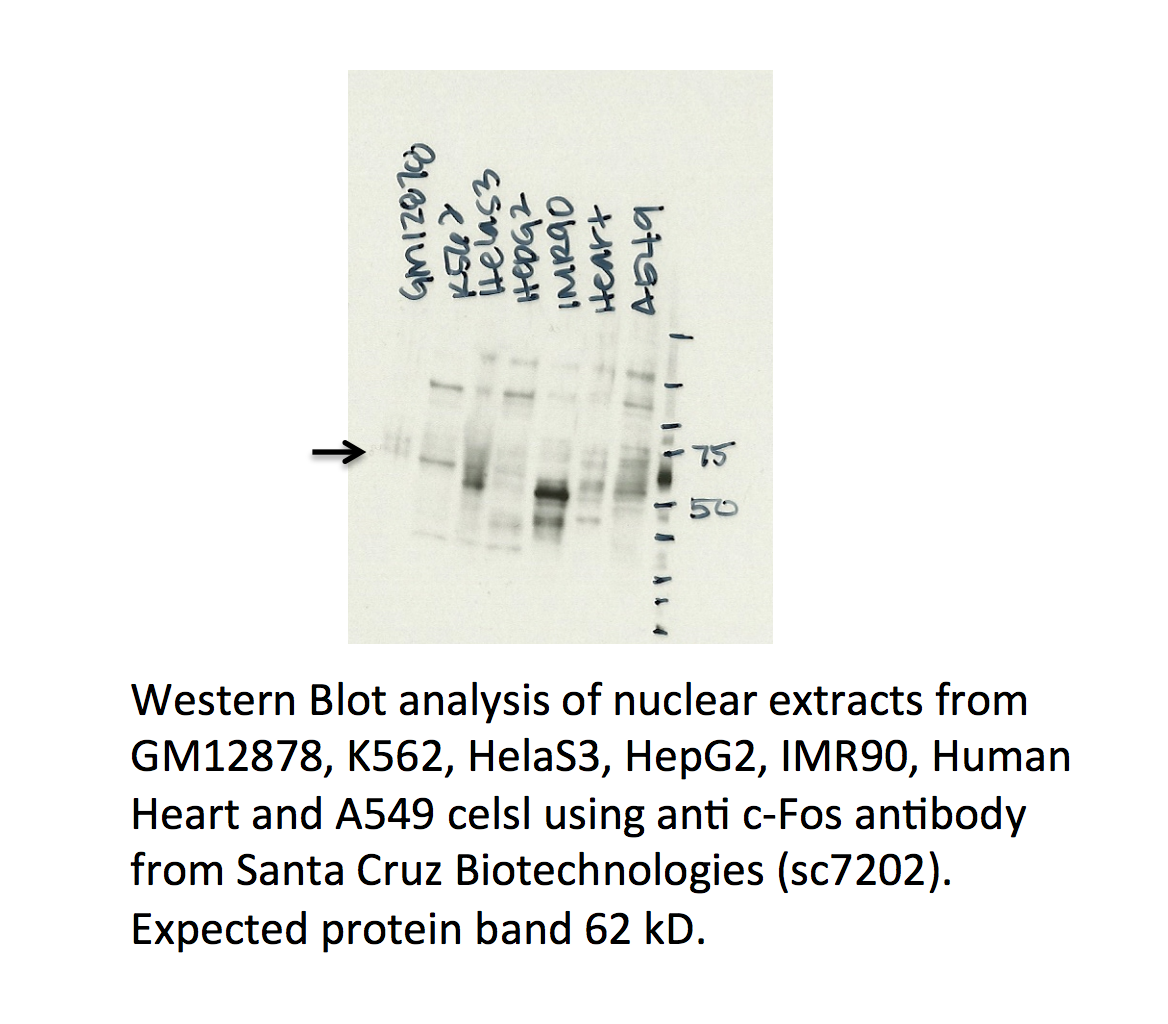ENCAB000AEQ
Antibody against Homo sapiens FOS
Homo sapiens
IMR-90, MCF-7
characterized to standards
Homo sapiens
any cell type or tissue
partially characterized
Homo sapiens
GM12878, K562, HeLa-S3, HepG2, heart, A549
not characterized to standards
- Status
- released
- Source (vendor)
- Santa Cruz Biotech
- Product ID
- sc-7202
- Lot ID
- K0810
- Characterized targets
- FOS (Homo sapiens)
- Host
- rabbit
- Clonality
- polyclonal
- Purification
- affinity
- Antigen description
- amino acids 210-335 mapping at the C-terminus of c-Fos of human origin.
- External resources
Characterizations
FOS (Homo sapiens)
not submitted for review by lab
- Caption
- Immunoprecipitation was performed on nuclear extracts from the cell line: HepG2, using the antibody sc-7202. The blot shows western blot analysis of input, flowthrough, immunoprecipitate and mock immunoprecipitate using IgG.Molecular Weight: 62.0
- Submitted by
- Nathaniel Watson
- Lab
- Michael Snyder, Stanford
- Grant
- U54HG006996
- Download
- 1125_04_Fos_sc-7202.jpg
FOS (Homo sapiens)
Method: motif enrichment
compliant
- Caption
- The motif for target FOS is represented by the attached position weight matrix (PWM) derived from ENCFF277MLU. Motif enrichment analysis was done by Dr. Zhizhuo Zhang (Broad Institute, Kellis Lab) using known motifs (http://compbio.mit.edu/encode-motifs/) and previously published ChIP-seq data (http://www.broadinstitute.org/~zzhang/motifpipeline/data/TrainSetInfo.txt). The accept probability score of the given transcription factor was calculated using a Bayesian approach. This analysis also includes three motif enrichment scores, computed by overlapping the motif instances with the given ChIP-seq peak locations, as well as an enrichment rank. For more information on the underlying statistical methods, please see the attached document. Accept probability score: 0.828394776 Global enrichment Z-score: 12.06665449 Positional bias Z-score: 14.72184371 Peak rank bias Z-score: 7.637519152 Enrichment rank: 1.0
- Submitted by
- Kathrina Onate
- Lab
- Michael Snyder, Stanford
- Grant
- U54HG006996
FOS (Homo sapiens)
IMR-90IMR-90
compliant
- Caption
- Immunoprecipitation was performed on nuclear extracts from the cell line: IMR90, using the antibody sc-7202. The blot shows western blot analysis of input, flowthrough, immunoprecipitate and mock immunoprecipitate using IgG.Molecular Weight: 62.0
- Reviewer comment
- Runs a bit smaller than expected size, but is within allowed 20% deviation.
- Submitted by
- Nathaniel Watson
- Lab
- Michael Snyder, Stanford
- Grant
- U54HG006996
- Download
- Fos (ENCAB000AEQ)_IMR90.jpg
FOS (Homo sapiens)
MCF-7
compliant
- Caption
- Immunoprecipitation was performed on nuclear extracts from the cell line: MCF-7, using the antibody sc-7202. The blot shows western blot analysis of input, flowthrough, immunoprecipitate and mock immunoprecipitate using IgG.Molecular Weight: 62.0
- Reviewer comment
- Runs a bit smaller than expected size, but is within allowed 20% deviation.
- Submitted by
- Minyi Shi
- Lab
- Michael Snyder, Stanford
- Grant
- U54HG006996
- Download
- Fos (ENCAB000AEQ)_MCF7.jpg
FOS (Homo sapiens)
HepG2MCF-7IMR-90
not compliant
- Caption
- Western blot analysis of nuclear lysates prepared from multiple cells lines loaded in the order: HepG2, MCF7, IMR90 using the antibody sc-7202. Molecular Weight: 62.0
- Submitter comment
- HepG2 should be reviewed. Isoform 2 (Uniprot: [P01100-2]) is around ~28kD for the smaller band.
- Reviewer comment
- Banding pattern is inconsistent across all cell types, particularly near expected size.
- Submitted by
- Nathaniel Watson
- Lab
- Michael Snyder, Stanford
- Grant
- U54HG006996
FOS (Homo sapiens)
Method: immunoprecipitation
not reviewed
- Caption
- Western blot analysis of nuclear extracts prepared from multiple human cells lines using the anti c-Fos (sc-7202) antibody detects a band corresponding to the expected molecular weight of human c-Fos (62KD).
- Submitted by
- Michael Snyder
- Lab
- Michael Snyder, Stanford
- Grant
- U54HG004558
- Download
- human_c-Fos_validation_Snyder.pdf
FOS (Homo sapiens)
Method: motif enrichment
not reviewed
- Caption
- Calculations were done by Alan Boyle using a collection of known motifs. Table 1 shows the fold-enrichments and fraction of peaks which contain the motif. The motif which produced the largest value for each criterion is shown in Table 1. Note that while the maximally enriched motifs may differ from the motif with the highest enrichment p-values and the most represented motif, the motifs are highly similar (Figure 1) and thus all values are similar between motifs. Motifs were identified using a matching stringency corresponding to 4-6 (6mer). Peaks identified by IDR (1% cutoff) were used in the analysis and +/-50bp from peak centers were considered. Enrichments are for a given motif vs. a background consisting of +/- 50bp from the centers of all DnaseI hypersensitive peaks. Repeat mask/simple repeats from UCSC and all gencode v7 exons (including non-protein coding genes) were excluded from the analysis. Comparison to shuffle motifs were used to correct for compositional bias. Enrichment is the corrected # of motifs in ChIP peaks/corrected # of motifs in DNaseI peaks. The current ENCODE standard calls for >4-fold enrichment and >10% motif representation for this criteria to be used for validation. The 4 c-Fos datasets presented here exceed these thresholds and sc-7202 is considered validated.
- Submitted by
- Michael Snyder
- Lab
- Michael Snyder, Stanford
- Grant
- U54HG004558
- Download
- human_c-Fos_validation_Snyder.pdf
FOS (Homo sapiens)
GM12878K562HeLa-S3HepG2IMR-90heartA549
not compliant
- Caption
- Western blot analysis of nuclear extracts prepared from multiple human cells lines using the anti c-Fos (sc-7202) antibody detects a band corresponding to the expected molecular weight of human c-Fos (62KD).
- Reviewer comment
- Non-compliant lanes either are not within 20% of expected size, or does not correspond to >50% of all bands on gel
- Submitted by
- Kathrina Onate
- Lab
- Michael Snyder, Stanford
- Grant
- U54HG004558
- Download
- WB Snyder AEQ.png




